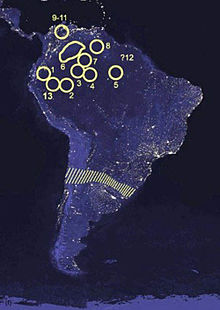Lucihormetica luckae
| Lucihormetica luckae | ||||||||||||
|---|---|---|---|---|---|---|---|---|---|---|---|---|

Lucihormetica luckae ; left in daylight, right bioluminescence in the dark. |
||||||||||||
| Systematics | ||||||||||||
|
||||||||||||
| Scientific name | ||||||||||||
| Lucihormetica luckae | ||||||||||||
| Vršanský , Fritzsche & Chorvát , 2012 |
Lucihormetica luckae is a cockroach from the Blaberidae family . It is one of the 13 cockroaches discovered so far (as of 2012) thatare capable of bioluminescence ; it is the only one of these species to be found in Ecuador. With its glow it imitates the poisonous click beetles of the genus Pyrophorus . The species has not been found since it was discovered in 1939. The Tungurahua eruptionin December 2010 destroyed the area around the site of discovery, which is why it is assumed that the species is extinct. However, it cannot be ruled out that the cause of the extinction is light pollution , as the night sky over the site is still dark today, but is surrounded by light-polluted areas a few dozen kilometers away. All known other bioluminescent cockroach species are essentially only found in habitats with very dark night skies.
features
The cockroach has a body length of about 24 millimeters and a width of about 14 millimeters and is therefore only about half the size of the other species in the genus Lucihormetica . Like all species of this genus, however, it has two conspicuous luminous organs on the pronotum . These measure around 1.8 millimeters in diameter. Another small light organ with a diameter of only 0.25 millimeters is arranged asymmetrically near the right light organ. Large parts of the body also fluoresce, such as the legs or wings. However, these body parts shine much weaker than the luminous organs and also do not contain any luciferin . Like only Lucihormetica grossi and Lucihormetica amazonica , the species has a strongly arched body with long fore wings that cover the entire body. From its sister species , L. amazonica , it differs in a less strongly triangular head, less clearly developed tubercles on the pronotum and a less conspicuous body color. L. grossi has darker colored basal fore wings and an equally colored pronotum, which also has two pale spots at the base. For lucihormetica luckae also is characteristic that in the male reproductive organs that sclerite is formed L3, which is round in cross section and also has a hook of the type "HLA". The species is asymmetrical in appearance. This is evident not only from the small luminous organ that is only formed on the right, but also from the dark stripes running diagonally across the body.
The mouthparts are directed obliquely downwards and backwards (hypognathic). The head is moderately large at 4.5 by 4.1 millimeters and has slim antennae that are only 0.25 to 0.38 millimeters thick . The first three antenna elements are relatively short at 0.9, 0.2 and 0.6 millimeters in length. The maxillary palps are short and strong and carry numerous short sensillae (Sensilla Chaetica). The head does not have any bioluminescent areas. The extremities are short, massive and provided with strong spurs. The hips ( coxes ) have numerous sensillae ventrally , long setae at the back and dense, small chaetica at the points of contact with the adjacent hips. All thigh rings ( trochanters ) are very large and have a clearly separated area in the middle and setae at the back. The thighs ( femora ) have numerous long, fine setae on the sides and a very short but powerful spur at the end. The rails ( tibia ) are strongly provided with very strong spurs up to 1.3 millimeters long. The tarsi are strong. The basitarsus and claw are long, the remaining three limbs are short. Pulvilli are clearly formed and transparent. They fluoresce and can presumably also actively glow.
Way of life
The way of life of the species is unknown.
Taxonomy and systematics
The species was first described by Vršanský, Fritzsche and Chorvát in 2012 using a specimen collected by William Clarke-Macintyre in Baños , Tungurahua Province (Ecuador) on May 5, 1939. The holotype is in the Natural History Museum in Washington, DC The specific epithet luckae is derived from the nickname "Lucka" of the daughter Lucia of Peter Vršanský , one of the first descriptors.
supporting documents
- ↑ a b c d e Peter Vršanský, Dušan Chorvát, Ingo Fritzsche, Miroslav Hain, Robert Ševčík (2012): Light-mimicking cockroaches indicate Tertiary origin of recent terrestrial luminescence. Natural Sciences , 99 (9), pp. 739-749, doi : 10.1007 / s00114-012-0956-7 .

